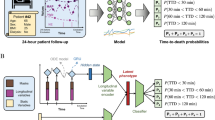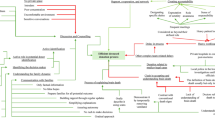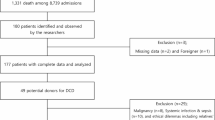Abstract
Circulatory–respiratory or brain tests are widely accepted for definition and determination of death, but have several controversial issues. Both determinations have been stimulated by organ donation, but must be valid independently of this process. Current controversies in brain death include whether the definition is conceptually coherent, whether the whole-brain or brainstem criterion is correct, whether one neurological examination or two should be required, and when to conduct the examination following therapeutic hypothermia. Controversies about the circulatory determination of death include the minimum duration of asystole that is sufficient for death to be declared, and whether the distinction between permanent and irreversible cessation of circulatory functioning is important. In addition, the goal of organ donation raises issues such as the optimal way to time and conduct the request conversation with family members of the patient, and whether the Dead Donor Rule should be abandoned.
Key Points
-
Death can be determined by circulatory–respiratory or brain tests
-
All brain death practices use the whole-brain or brainstem criterion of death
-
Controversies about brain death focus on the coherence of the concept, the extent of necessary neuronal damage, and the tests required to prove irreversibility
-
Controversies about circulatory death focus on the required duration of asystole before death can be declared, and whether permanent or irreversible cessation should be the standard
-
The option of organ donation should be presented to families of deceased patients, but the optimal timing of and approach to the donation request remain unclear
This is a preview of subscription content, access via your institution
Access options
Subscribe to this journal
Receive 12 print issues and online access
$189.00 per year
only $15.75 per issue
Buy this article
- Purchase on SpringerLink
- Instant access to full article PDF
Prices may be subject to local taxes which are calculated during checkout
Similar content being viewed by others
References
Giacomini, M. A change of heart and a change of mind? Technology and the redefinition of death in 1968. Soc. Sci. Med. 44, 1465–1482 (1997).
Powner, D. J., Ackerman, B. M. & Grenvik, A. Medical diagnosis of death in adults: historical contributions to current controversies. Lancet 348, 1219–1223 (1996).
Bernat, J. L., Culver, C. M. & Gert, B. On the definition and criterion of death. Ann. Intern. Med. 94, 389–394 (1981).
Wijdicks, E. F. The neurologist and Harvard criteria for brain death. Neurology 61, 970–976 (2003).
Belkin, G. S. Brain death and the historical understanding of bioethics. J. Hist. Med. Allied Sci. 58, 325–361 (2003).
Pernick, M. S. in The Definition of Death: Contemporary Controversies (eds Youngner, S. J. et al.) 3–33 (Johns Hopkins University Press, Baltimore, 1999).
Mollaret, P. & Goulon, M. Le coma dépassé (mémoire préliminaire) [French]. Rev. Neurol. (Paris) 101, 3–15 (1959).
Wertheimer, P., Jouvet, M. & Descotes, J. A propos du diagnostic de la morte du système nerveux dans les comas avec arrêt respiratoire traités par respiration artificielle [French]. Presse Méd. 67, 87–88 (1959).
[No authors listed]. A definition of irreversible coma. Report of the Ad Hoc Committee of the Harvard Medical School to Examine the Definition of Brain Death. JAMA 205, 337–340 (1968).
[No authors listed] Diagnosis of brain death. Lancet 2, 1069–1070 (1976).
Pallis, C. ABC of Brainstem Death (British Medical Journal Publishers, London, 1983).
Wijdicks, E. F. Brain death worldwide: accepted fact but no global consensus in diagnostic criteria. Neurology 58, 20–25 (2002).
Wijdicks, E. F. Brain Death 2nd edn (Oxford University Press, New York, 2011).
Beresford, H. R. Brain death. Neurol. Clin. 17, 295–306 (1999).
Korein, J. The problem of brain death: development and history. Ann. NY Acad. Sci. 315, 19–38 (1978).
President's Commission for the Study of Ethical Problems in Medicine and Biomedical and Behavioral Research. Defining Death: Medical, Ethical, and Legal Issues in the Determination of Death (US Government Printing Office, Washington, DC, 1981).
Bernat, J. L., Culver, C. M. & Gert, B. Defining death in theory and practice. Hastings Cent. Rep. 12 (1), 5–8 (1982).
Bernat, J. L. A defense of the whole-brain concept of death. Hastings Cent. Rep. 28 (2), 14–23 (1998).
Bernat, J. L. The biophilosophical basis of whole-brain death. Soc. Philos. Policy 19, 324–342 (2002).
Bernat, J. L. The whole-brain concept of death remains optimum public policy. J. Law Med. Ethics 34, 35–43 (2006).
Shewmon, D. A. Constructing the death elephant: a synthetic context shift for the definition, criteria, and tests for death. J. Med. Philos. 35, 256–298 (2010).
Miller, F. A. & Truog, R. D. Death, Dying and Organ Transplantation: Reconstructing Medical Ethics at the End of Life (Oxford University Press, New York, 2011).
Halevy, A. & Brody, B. Brain death: reconciling definitions, criteria, and tests. Ann. Intern. Med. 119, 519–525 (1993).
Bernat, J. L. Contemporary controversies in the definition of death. Prog. Brain Res. 177, 21–31 (2009).
Chiong, W. Brain death without definitions. Hastings Cent. Rep. 35 (6), 20–30 (2005).
Shewmon, D. A. The brain and somatic integration: insights into the standard biological rationale for equating “brain death” with death. J. Med. Philos. 26, 457–478 (2001).
Loeb, J. The Organism as a Whole: From a Physicochemical Viewpoint (G. P. Putnam's Sons, New York, 1916).
Clayton, P. & Kauffman, S. A. On emergence, agency, and organization. Biol. Philos. 21, 501–521 (2006).
Bonelli, R. M., Prat, E. H. & Bonelli, J. Philosophical considerations on brain death and the concept of the organism as a whole. Psychiatr. Danub. 21, 3–8 (2009).
Shewmon, D. A. The “critical organ” for the organism as a whole: lessons from the lowly spinal cord. Adv. Exp. Med. Biol. 550, 23–42 (2004).
Bernat, J. L. How much of the brain must die in brain death? J. Clin. Ethics 3, 21–26 (1992).
Wijdicks, E. F., Varelas, P. N., Gronseth, G. S. & Greer, D. M. American Academy of Neurology. Evidence-based guideline update: determining brain death in adults: report of the Quality Standards Subcommittee of the American Academy of Neurology. Neurology 74, 1911–1918 (2010).
Nakagawa, T. A. et al. Guidelines for the determination of brain death in infants and children: an update of the 1987 Task Force recommendations. Crit. Care Med. 39, 2139–2155 (2011).
Shemie, S. D. et al. Severe brain injury to neurological determination of death: Canadian forum recommendations. CMAJ 174, S1–S13 (2006).
Gardiner, D., Shemie, S., Manara, A. & Opdam, H. International perspective on the diagnosis of death. Br. J. Anaesth. 108 (Suppl. 1), i14–i28 (2012).
Posner, J. B., Saper, C. B., Schiff, N. D. & Plum, F. Plum and Posner's Diagnosis of Stupor and Coma 4th edn 95–114 (Oxford University Press, New York, 2007).
Ropper, A. H. Lateral displacement of the brain and level of consciousness in patients with an acute hemispheral mass. N. Engl. J. Med. 314, 953–958 (1986).
Bernat, J. L. On irreversibility as a prerequisite for brain death determination. Adv. Exper. Med. Biol. 550, 161–167 (2004).
Ogata, J., Imakita, M., Yutani, C., Miyamoto, S. & Kikuchi, H. Primary brainstem death: a clinico-pathological study. J. Neurol. Neurosurg. Psychiatry 51, 646–650 (1988).
Kosteljanitz, M., Øhrstrøm, J. K., Skjøt, S. & Teglbjærg, P. S. Clinical brain death with preserved arterial circulation. Acta Neurol. Scand. 78, 418–421 (1988).
Machado, C. Consciousness as a definition of death: its appeal and complexity. Clin. Electroencephalogr. 30, 156–164 (1999).
Shewmon, D. A. Brain death: can it be resuscitated? Hastings Cent. Rep. 39 (2), 18–24 (2009).
Truog, R. D. Is it time to abandon brain death? Hastings Cent. Rep. 27 (1), 29–37 (1997).
Shewmon, D. A. Chronic “brain death:” meta-analysis and conceptual consequences. Neurology 51, 1538–1545 (1998).
Repertinger, S., Fitzgibbons, W. P., Omojola, M. F. & Brumback, R. A. Long survival following bacterial meningitis-associated brain destruction. J. Child Neurol. 21, 591–595 (2006).
Lustbader, D. et al. Second brain death examination may negatively affect organ donation. Neurology 76, 119–124 (2011).
Gelb, D. J. Second brain death examination may negatively affect organ donation. Neurology 77, 1314–1315 (2011).
Varelas, P. N. et al. Single brain death examination is equivalent to dual brain death examinations. Neurocrit. Care 15, 547–553 (2011).
Heran, M. K., Heran. N. S. & Shemie, S. D. A review of ancillary tests in evaluating brain death. Can. J. Neurol. Sci. 35, 409–419 (2008).
Wijdicks, E. F. The case against confirmatory tests for determining brain death in adults. Neurology 75, 77–83 (2010).
Busl, K. M. & Greer, D. M. Pitfalls in the diagnosis of brain death. Neurocrit. Care 11, 276–287 (2009).
Greer. D. M., Varelas, P. N., Haque, S. & Wijdicks, E. F. Variability of brain death determination guidelines in leading US neurologic institutions. Neurology 70, 284–289 (2008).
Wang, M. Y., Wallace, P. & Gruen, J. P. Brain death documentation: analysis and issues. Neurosurgery 51, 731–736 (2002).
Bernat, J. L. How can we achieve uniformity in brain death determinations? Neurology 70, 252–253 (2008).
Choi, E. K. et al. Brain death revisited: the case for a national standard. J. Law Med. Ethics 36, 824–836 (2008).
Webb, A. C. & Samuels, O. B. Reversible brain death after cardiopulmonary arrest and induced hypothermia. Crit. Care Med. 39, 1538–1542 (2011).
Streat, S. 'Reversible brain death'—is it true, confounded, or 'not proven'? Crit. Care Med. 39, 1601–1602 (2011).
Miedema, F. Medical treatment after brain death: a case report and ethical analysis. J. Clin. Ethics 2, 50–52 (1991).
Hardwig, J. Treating the brain dead for the benefit of the family. J. Clin. Ethics 2, 53–56 (1991).
Molinari, G. F. Brain death, irreversible coma, and words doctors use. Neurology 32, 400–402 (1982).
Cranford, R. E. Discontinuation of ventilation after brain death: policy should be balanced with concern for the family. BMJ 318, 1754–1755 (1999).
Shaner, D. M., Orr, R. D., Drought, T., Miller, R. B. & Siegel, M. Really, most SINCERELY dead: policy and procedure in the diagnosis of death by neurologic criteria. Neurology 62, 1683–1686 (2004).
Ormrod, J. A., Ryder, T., Chadwick, R. J. & Bonner, S. M. Experiences of families when a relative is diagnosed brain stem dead: understanding of death, observation of brain stem death testing, and attitudes to organ donation. Anaesthesia 60, 1002–1008 (2005).
Kompanje, E. J., de Groot, Y. J., Bakker, J. & Ijzermans, J. N. A national multicenter trial on family presence during brain death determination: the FABRA study. Neurocrit. Care 17, 301–308 (2012).
Furton, E. J. Brain death, the soul, and organic life. Natl Cathol. Bioeth. Q. 2, 455–470 (2002).
Pontifical Academy of Sciences. The Signs of Death. Scripta Varia 110 (Pontifical Academy of Sciences, Vatican City, 2007).
Halachic Organ Donor Society. Halachic Issues. Halachic Organ Donor Society [online].
Rosner, F. in The Definition of Death: Contemporary Controversies (eds Youngner, S. J. et al.) 210–221 (Johns Hopkins University Press, Baltimore, 1999).
Padela A. I., Arozullah, A. & Moosa, E. Brain death in Islamic ethico-legal deliberation: challenges for applied Islamic bioethics. Bioethics http://dx.doi.org/10.1111/j.1467–85192011.01935.x.
Jain, S. & Maheshawari, M. C. in Brain Death (ed. Machado, C.) 261–263 (Elsevier, Amsterdam, 1995).
Lock, M. Contesting the natural in Japan: moral dilemmas and technologies of dying. Cult. Med. Psychiatry 19, 1–38 (1995).
Olick, R. S., Braun, E. A. & Potasj, J. Accommodating religious and moral objections to neurological death. J. Clin. Ethics 20, 183–191 (2009).
Steinbrook, R. Organ donation after cardiac death. N. Engl. J. Med. 357, 209–213 (2007).
Manara, A. R., Murphy, P. G. & O'Callaghan, G. Donation after circulatory death. Br. J. Anaesth. 108 (Suppl. 1), i108–i121 (2012).
Wall, S. P. et al. Derivation of the uncontrolled donation after circulatory death protocol for New York City. Am. J. Transplant. 11, 1417–1426 (2011).
Robertson, J. A. The dead donor rule. Hastings Cent. Rep. 29 (6), 6–14 (1999).
Lynn, J. & Cranford, R. E. in The Definition of Death: Contemporary Controversies (eds Youngner, S. J. et al.) 101–114 (Johns Hopkins University Press, Baltimore, 1999).
DeVita, M. A. & Snyder, J. V. Development of the University of Pittsburgh Medical Center policy for the care of terminally ill patients who may become organ donors after death following the removal of life support. Kennedy Inst. Ethics J. 3, 131–143 (1993).
Bernat, J. L. Are donors after cardiac death really dead? J. Clin. Ethics 17, 122–132 (2006).
Ethics Committee, American College of Critical Care Medicine & Society of Critical Care Medicine. Recommendations for non-heartbeating organ donation. A position paper by the Ethics Committee, American College of Critical Care Medicine, Society of Critical Care Medicine. Crit. Care Med. 29, 1826–1831 (2001).
Bernat, J. L. et al. Report of a national conference on donation after cardiac death. Am. J. Transplant. 6, 281–291 (2006).
Institute of Medicine. Non-Heart-Beating Organ Transplantation: Practice and Protocols (National Academy Press, Washington, DC, 2000).
Shemie, S. D. et al. National recommendations for donation after cardiocirculatory death in Canada. CMAJ 175 (8 Suppl.), S1–S24 (2006).
Dhanini, S., Hornby, L., Ward, R. & Shemie, S. Variability in the determination of death after cardiac arrest: a review of guidelines and statements. J. Intensive Care Med. 27, 238–252 (2012).
Boucek, M. M. et al. Pediatric heart transplantation after declaration of cardiocirculatory death. N. Engl. J. Med. 359, 709–714 (2008).
Wijdicks, E. F. & Diringer, M. N. Electrocardiographic activity after terminal cardiac arrest in neurocatastrophes. Neurology 62, 673–674 (2004).
DeVita, M. A., Snyder, J. V., Arnold, R. M. & Siminoff, L. A. Observations of withdrawal of life-sustaining treatment from patients who became non-heart-beating organ donors. Crit. Care Med. 28, 1709–1712 (2000).
Hornby, K., Hornby, L. & Shemie, S. A systematic review of autoresuscitation after cardiac arrest. Crit. Care Med. 38, 1246–1253 (2010).
Sheth, K. N., Nutter, T., Stein, D. M., Scalea, T. M. & Bernat, J. L. Auto-resuscitation after asystole in patients being considered for organ donation. Crit. Care Med. 40, 158–161 (2012).
Rogers, P. L., Schlicktig, R., Miro, A. & Pinsky, M. Auto-PEEP during CPR: an “occult” cause of electromechanical dissociation. Chest 99, 492–493 (1991).
Bernat, J. L. How auto-resuscitation impacts death determinations in organ donors. Crit. Care Med. 38, 1377–1378 (2010).
Bernat, J. L. How the distinction between “irreversible” and “permanent” illuminates circulatory–respiratory death determination. J. Med. Philos. 35, 242–255 (2010).
Truog, R. D. & Miller, F. G. Counterpoint: are donors after circulatory death really dead and does it matter? No and not really. Chest 138, 16–19 (2010).
Marquis, D. Are DCD donors dead? Hastings Cent. Rep. 40 (3), 24–31 (2010).
Bernat, J. L. et al. The circulatory–respiratory determination of death in organ donation. Crit. Care Med. 38, 972–979 (2010).
Ko, W. J., Chen, Y. S., Tsai, P. R. & Lee, P. H. Extracorporeal membrane oxygenation support of donor abdominal organs in non-heart-beating donors. Clin. Transplant. 14, 152–156 (2000).
Gravel, M. T. et al. Kidney transplantation from organ donors following cardiopulmonary death using extracorporeal membrane oxygenation support. Ann. Transplant. 9, 57–58 (2004).
Magliocca, J. F. et al. Extracorporeal support for organ donation after cardiac death effectively expands the donor pool. J. Trauma 58, 1095–1102 (2005).
President's Council on Bioethics. Controversies in the Determination of Death: A White Paper by the President's Council on Bioethics. The President's Council on Bioethics [online].
Shemie, S. D. International Guidelines for the Determination of Death. Critical Care Canada Forum [online].
Klein, A. S. et al. Organ donation and utilization in the United States: 1998–2008. Am. J. Transplant. 10, 973–986 (2010).
Merchant, S. J. et al. Exploring the psychological effects of deceased organ donation on the families of organ donors. Clin. Transplant. 22, 341–347 (2008).
DeVita, M. A. & Caplan, A. L. Caring for organs or patients? Ethical concerns about the Uniform Anatomical Gift Act (2006). Ann. Intern. Med. 147, 876–879 (2007).
Iltis, A. S., Rie, M. A. & Wall, A. Organ donation, patients' rights, and medical responsibilities at the end of life. Crit. Care Med. 37, 310–315 (2009).
Truog, R. D. Consent for organ donation—balancing conflicting ethical obligations. N. Engl. J. Med. 358, 1209–1211 (2008).
Arnold, R. M., Siminoff, L. A. & Frader, J. E. Ethical issues in organ procurement: a review for intensivists. Crit. Care Clin. 12, 29–48 (1996).
Mandell, M. S. et al. National evaluation of healthcare provider attitudes toward organ donation after cardiac death. Crit. Care Med. 34, 2952–2958 (2006).
Hart, J. L., Kohn, R. & Halpern, S. D. Perceptions of organ donation after circulatory determination of death among critical care physicians and nurses: a national survey. Crit. Care Med. 40, 2595–2600 (2012).
Bastami, S., Krones, T. & Biller-Adorno, N. Systematic review of attitudes toward donation after cardiac death among health care providers and the general public. Crit. Care Med. (in press).
Simpkin, A. L., Robertson, L. C., Barber, V. S. & Young, J. D. Modifiable factors influencing relatives' decision to offer organ donation: systematic review. BMJ 338, b991 (2009).
Kalkbrenner, K. J. & Hardart, G. E. Consent for donation after cardiac death: a survey of procurement organizations. J. Intensive Care Med. 27, 253–263 (2012).
Zink, S. & Wertleib, S. A study of the presumptive approach to consent for organ donation: a new solution to an old problem. Crit. Care Nurse 26, 129–136 (2006).
Luskin, R. S., Glazier, A. K. & Delmonico, F. L. Organ donation and dual advocacy. N. Engl. J. Med. 358, 1207–1208 (2008).
Browne, A., Gillett, G. & Tweedale, M. The ethics of elective (non-therapeutic) ventilation. Bioethics 14, 42–57 (2000).
Bernat, J. L. Point: are donors after circulatory death really dead and does it matter? Yes and Yes. Chest 138, 13–16 (2010).
Author information
Authors and Affiliations
Ethics declarations
Competing interests
The author declares no competing financial interests.
Rights and permissions
About this article
Cite this article
Bernat, J. Controversies in defining and determining death in critical care. Nat Rev Neurol 9, 164–173 (2013). https://doi.org/10.1038/nrneurol.2013.12
Published:
Issue date:
DOI: https://doi.org/10.1038/nrneurol.2013.12
This article is cited by
-
The History of Donation after Circulatory Death (DCD): Backlash and Boomerang
Neurocritical Care (2024)
-
Rationale for revisions to the definition of death and criteria for its determination in Canada
Canadian Journal of Anesthesia/Journal canadien d'anesthésie (2023)
-
The ethical obligation of the dead donor rule
Medicine, Health Care and Philosophy (2020)
-
Medicolegal Complications of Apnoea Testing for Determination of Brain Death
Journal of Bioethical Inquiry (2018)
-
Donation after brain circulation determination of death
BMC Medical Ethics (2017)



